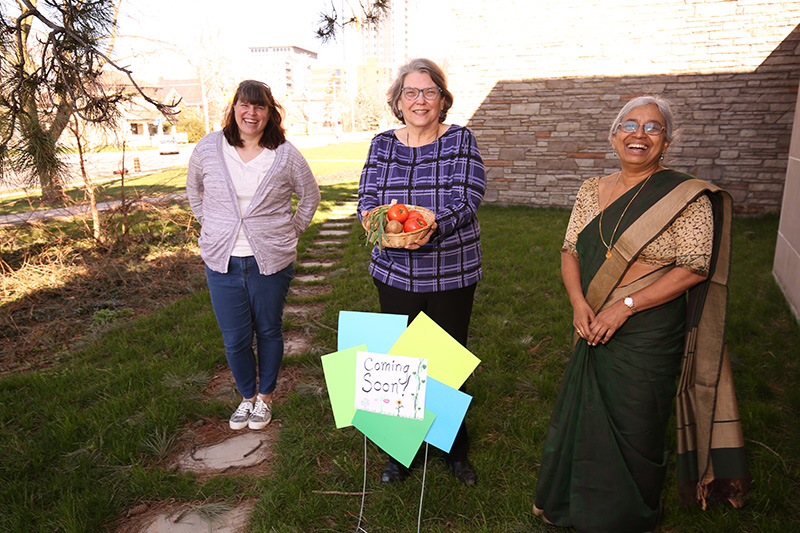We use cookies on this site to enhance your experience.
By selecting “Accept” and continuing to use this website, you consent to the use of cookies.

As winter approaches, another growing season at Luther’s Food Justice Garden finishes. This year was one of significant growth and new learning opportunities for students.
What started in the summer of 2022 as a plan to utilize untapped potential in Luther’s outdoor spaces for a small vegetable garden, has become so much more in what’s now its fourth growing season.
The garden sits alongside Luther’s building facing Albert St., and is run by a team of volunteers, including Luther and Laurier students and alumni.

This project is a partnership between Laurier Students’ Public Interest Research Group (LSPIRG) and Luther. Karly Rath, Volunteer and Community Engagement Director at LSPIRG, has seen the garden thrive and take new forms since its initial development.
“It’s grown and changed each year. Last year we doubled the number of raised beds. This year, we installed the greenhouse with support of Luther faculty member Mary (Joy) Philip, and implemented weekly learning sessions for students,” said Rath.
The garden grows vegetables, fruit, herbs and pollinator flowers that provide fresh produce to students facing food insecurity at the Free Weekly Distro program on campus.
With new implementations this year, there comes even more opportunities for students to continue experiential learning.
“The new greenhouse will allow us to extend the season,” said Rath. “Instead of the season ending at first frost, we’ll be able to extend it into November, which is particularly valuable because the growing season doesn’t necessarily coincide well with students being on campus.”
Rath found that a lot of students joining in fall are excited to be involved and really start to build a sense of community. This is something the garden team wanted to extend further into the school year.

Another implementation new to this year is the weekly hands-on learning workshops overseen by Aaron El Sabrout, the Garden Coordinator. These workshops are free for any student to join and learn skills around sustainable growing.
“I have a background in foraging, community herbalism and permaculture gardening, so initially a lot of sessions were skill-sharing and informational,” said El Sabrout. “We walked in Waterloo Park to learn about foraging and plants, along with several sessions about plant identification, where we learned about the basics of plant anatomy and how to take notes to make proper guide entries.”
The students contribute to a space they make their own through the work they collaborate on.
“We have conversations about where students want to plant and how things should be arranged, especially because it's their space through the university that's designated for them to learn about all these topics,” said El Sabrout.

Many new volunteers who join have never planted anything before or have very little familiarity with plants in the natural world, so a big part of the learning is teaching how each type of plant will grow and how to harvest.
Various sessions also incorporate guest lectures, including former students on topics like eco-anxiety. The sessions take a dual approach, where students learn hands-on skills but also learn about greater environmental and social impacts.
“There’s been interesting discussions between the students about what climate means to them,” said El Sabrout. “And we’ll explore topics like land-based issues including indigenous sovereignty.”
Although the garden has provided opportunity for students, it also provided opportunity for the university to find new ways to utilize untapped potential in unused space right on campus.
“When this started, Luther and LSPIRG were already working on food insecurity projects through the Distro program, so LSPIRG approached Luther and leadership was eager to utilize their unused space to be able to grow food, and now we have this incredible garden.”
Rath explained that there is real significance in using all campus space in beneficial ways for students and the community.
“Principal-Dean, Kristine Lund, was very supportive of acknowledging that lawn does nothing beneficial,” said Rath. “It doesn’t serve the planet and doesn’t serve the people.”
As campus thrives and Luther explores new ways to maximize efforts for learning, the university values the support of campus and community partners who help shape future possibilities here.

The garden is maintained and developed by funding and donations received by the Sustainable Hawk Fund and Luther’s Centre for Earth Consciousness and Gender Justice.
Mary (Joy) Philip, Assistant Principal at Luther has taken a lead role in securing funding for the growth of the garden.
“When I teach, when I speak with students, and when I hear their stories - that is what prompted me to make part of my sabbatical work to secure a greenhouse,” said Philip. “I had conversations with the Centre’s valued donors to make this a reality.”
Expenses towards the garden and greenhouse were made by Canadian Lutheran World Relief (CLWR) and Susan Antler, Executive Director of the Compost Council of Canada.
“We are an educational institution and an institution of the church,” said Philip. “The calling of both is to serve the neighbour. For us, our neighbours are the students that we serve.”
Philip notes that this project is part of a greater need to fulfil our job as a theological school to support students both inside and outside of the classroom.
"For students, we found there are food insecurity issues that needed to be addressed. There are students choosing between housing and food to eat, or clothes to buy and going to class,” said Philip. "Most often food becomes the last priority, and that affects everything else, even their mental disposition.”
The development of the garden provides a resource that affects many individuals on campus, and it’s easy to see how many people bring their own sense of dedication to bring it to life. The university is excited to see what new opportunities come to the Luther community as the garden space grows further.
